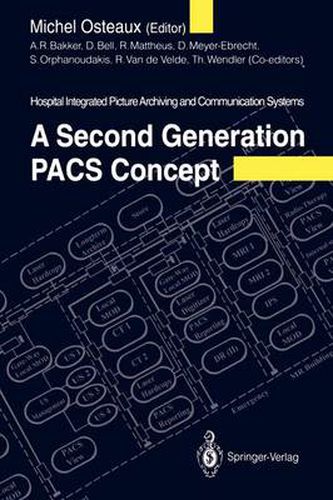Readings Newsletter
Become a Readings Member to make your shopping experience even easier.
Sign in or sign up for free!
You’re not far away from qualifying for FREE standard shipping within Australia
You’ve qualified for FREE standard shipping within Australia
The cart is loading…






This title is printed to order. This book may have been self-published. If so, we cannot guarantee the quality of the content. In the main most books will have gone through the editing process however some may not. We therefore suggest that you be aware of this before ordering this book. If in doubt check either the author or publisher’s details as we are unable to accept any returns unless they are faulty. Please contact us if you have any questions.
The term picture archiving and communications system (PACS) was initiated during the first International conference and workshop on the topic sponsored by The International Society for Optical Engineering (SPIE) in Newport Beach, California in 1982. The research and development (R&D) progress for PACS has been slow until 1988. The earlier PACS modules were mostly off the shelf components connected together to solve a very specific clinical problem. The three major players in PACS R&D are the European countries, United States of America, and Japan. For various reasons, the European coun tries concentrated in modeling and simulation, U.S.A. pre ferred in-house development or purchased PACS modules from a manufacturer, whereas Japan organized the PACS as a national project. Between 1989 and 1990 PACS R&D took a dramatic positive turn. Large scale P ACS projects were planned and some are of implementation, especially in newly con at various stages structed hospitals. Examples are the Hokkaido University, Japan; Hammersmith Hospital, United Kingdom; Social and Medical Center East (SMZO), Vienna, Austria; the U.S. Armed Force Medical Diagnostic Imaging Support (MDIS) project; and the UCLA Medical Plaza ambulatory care center. Another phenomenon is the organization of the EC-countries which provides a tremendous impetus for the European PACS R&D efforts. This book Hospital Integrated Picture Archiving and Communication Systems: edited by Professor M. Osteaux and others is a direct product from these efforts.
$9.00 standard shipping within Australia
FREE standard shipping within Australia for orders over $100.00
Express & International shipping calculated at checkout
This title is printed to order. This book may have been self-published. If so, we cannot guarantee the quality of the content. In the main most books will have gone through the editing process however some may not. We therefore suggest that you be aware of this before ordering this book. If in doubt check either the author or publisher’s details as we are unable to accept any returns unless they are faulty. Please contact us if you have any questions.
The term picture archiving and communications system (PACS) was initiated during the first International conference and workshop on the topic sponsored by The International Society for Optical Engineering (SPIE) in Newport Beach, California in 1982. The research and development (R&D) progress for PACS has been slow until 1988. The earlier PACS modules were mostly off the shelf components connected together to solve a very specific clinical problem. The three major players in PACS R&D are the European countries, United States of America, and Japan. For various reasons, the European coun tries concentrated in modeling and simulation, U.S.A. pre ferred in-house development or purchased PACS modules from a manufacturer, whereas Japan organized the PACS as a national project. Between 1989 and 1990 PACS R&D took a dramatic positive turn. Large scale P ACS projects were planned and some are of implementation, especially in newly con at various stages structed hospitals. Examples are the Hokkaido University, Japan; Hammersmith Hospital, United Kingdom; Social and Medical Center East (SMZO), Vienna, Austria; the U.S. Armed Force Medical Diagnostic Imaging Support (MDIS) project; and the UCLA Medical Plaza ambulatory care center. Another phenomenon is the organization of the EC-countries which provides a tremendous impetus for the European PACS R&D efforts. This book Hospital Integrated Picture Archiving and Communication Systems: edited by Professor M. Osteaux and others is a direct product from these efforts.